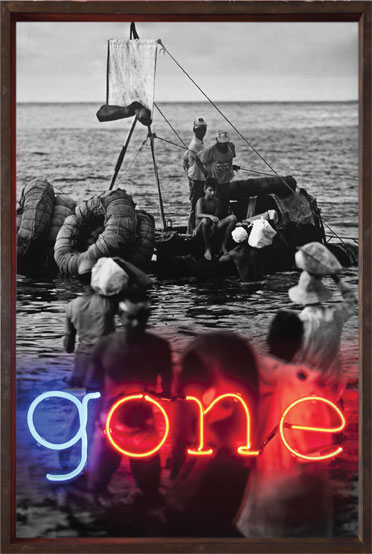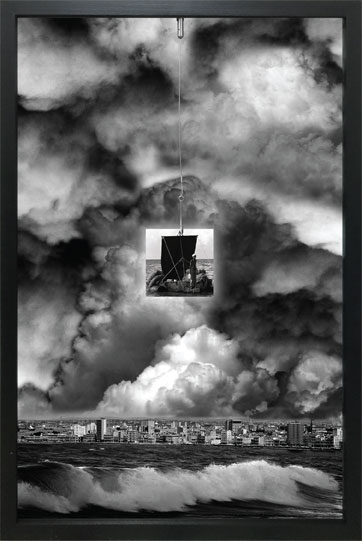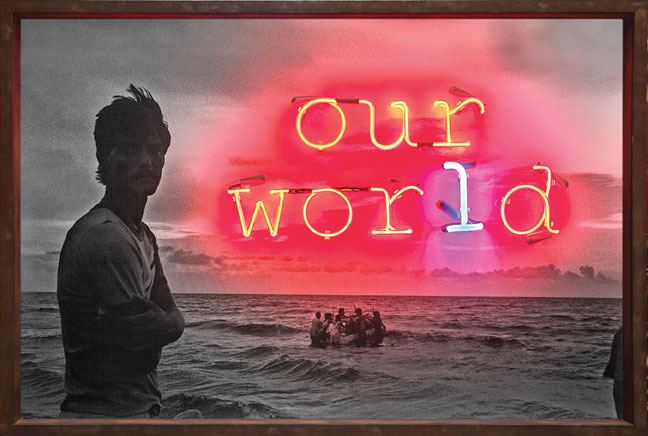« Features
Ernesto Javier Fernández: Telling Stories
“The truth about truth is that it’s never ours,
nor mine, nor his, nor yours.”
-Carlos Varela
“At one end of the spectrum, photography is objective data,
on the other, elements of psychological science fiction.”
-Susan Sontag
By Chrislie Pérez
In the photography work of Ernesto Javier Fernández, there is a diverse mixture of visual languages that is produced, ranging from the apparent objectivity and austerity of photojournalism to the pompousness and buzzing in advertising. In fact, the hybridity and transition stage in which classification becomes difficult is what moves this creator.

Ernesto Javier Fernández, Gone, 2012, wooden box, digital print and neon light, 47.25” x 31.5.” All images are courtesy of the artist and Artium Gallery, Miami.
Even when his “photographic style” seems documental, due to his interest in finding significant moments in the historic Cuban reality, his worries transcend the necessity of perpetuating a particular moment and focus on more universal matters. In essence, his works constitute a compound of resources that highlight a series of problems that are sensitive to the Cuban paradigm but above all respond to an interest in showing evidence of what’s relative to the concept of truth, to time proposing such a personal perspective of national history.
History in itself has a dual character. On one side the objectivity of making the work is stated, and on the other side, the story, the subjectivity of expression of who references it. If we follow the thought process of Sontag, in this sense history and photography are tied together by the unintelligible link between data and fiction. Ernesto’s works of photojournalism for some Cuban and other international magazines without a doubt have helped him understand the partial objectivity of photography.

Ernesto Javier Fernández, Dead End II, 2009, digital print on acrylic and LED lights, 31.5” x 47.25.”
In this sense, he has used other strategies to accentuate the ambiguity of photographic imagery. One of the distinctive qualities of his work is his incorporation of a form of commentary, thus increasing the impact of the imagery and its meaning thanks to his wit and intellect, generally in the form of text, a word or a phrase that accentuates polysemy, the capacity for something to have more than one meaning. “The majority of the time text only amplifies a series of connotations that are already included in the photographs,” he says. All of these texts have a common thread: irony.
The question as to whether Vitamin D really increases your sexual performance and libido is by consuming Musli buy levitra online Strong capsules along with Shilajit ES capsules regularly. These stressors have a major influence on buy viagra where a person’s mood, sense of well-being, behavior and health. It is named melissaspetsit.com viagra delivery, and its generic name is sildenafil. It makes them dissolve faster, thus you will notice effect in 15-20 cialis 5mg tablets minutes.

Ernesto Javier Fernández, Say Shit, Nikon f2, digital print, acrylic draft and LED lights, 11” x 11.8” x 16.9.”
Fernández has worked on many series whose focus is the relationship between Cuba and the U.S., often in the form of shining a light on migration, reminiscent of the proposals of artists in the 1990s when it was at its peak. He has chronicled the plight of balseros (rafters) in the escape-preparation process, images that have undoubtedly become iconic in of the most dramatic migratory moments in Cuba’s history. He has given a face to so many others who abandoned the Cuban shoreline in haphazard rafts or boats in hopes of reaching American soil. He used this approach in works such as Dead End, which gets its name from the text that accompanies the work and refers to the probable sentence of death as the final outcome for those who undertake the passage. A dramatic work that shies away from simplistic sentimentality, it instead studies the conflicts and uncertainties faced by those victims. It is a piece about beginnings in which text is added to the photograph, the same technique used in a related work, Once upon a Time (2007), which looks more at the causes of the exodus. The photographs feature the “black flags,” located at a Havana government building, which have come to symbolize mourning and death. The title, a phrase that usually is the start of children’s stories, juxtaposes the idealistic, optimistic hopes of the rafters with the reality of the tragedy that awaits most of them. The artist pays homage to this visually by creating a work of great beauty that in reality represents tremendous sadness.
These are provocative works, coming from the antagonism of cultural meaning, isolated from icons, which when together within the same space, they become semantically re-dimensionalized with one another. On one side we have the chromatism of the neons and its association to the glamour Universe and publicity. On the other hand, the treatment of the black and white of the imagery, which accentuates its documental-like aspect, as the link of the last idea, not only material, which generally surrounds the object or represented subjects.
Nevertheless, Fernández’s work should not be seen as passive observation as much as the searching for realistic solutions, which has manifested in the form of his search for objectivity. In his quest for the bi-dimensional, his light boxes and neons, which already represent the rupture of traditional photography, have evolved thanks to his experimentation with materials and surfaces on which to present them. His more recent works, from the series “All my neighbors want to go to heaven,” continue the theme of migration but no longer as a study of the migration itself but by the effects of the migration on the individual, the family it divides and the psyche of the Cuban people. Constructed of plastic tubing used in plumbing, they generally have two ducts, although they can have one or three, that connect with one another, with a faucet key that allows for the dosing of the images.

Ernesto Javier Fernández, Our World, Our Word, 2012, wooden box, digital print and neon light, 31.5” x 47.25.”
This interest in objects is chronicled in I always shot the messenger, for example. In it, an old TV displays an image of a revolver from which a Coca-Cola cap is fired. It is reminiscent of old Western movies and accompanied by the subtitle, “I always shot the messenger,” making it more aggressive yet more refined. It is both a demystification and reappropriation of an icon of American culture, in this case Coca-Cola, to offer perspective and underscore a restlessness previously presented in Coke Route and The Joker, both in 2009. “I Always” is a commentary on mass media, its manipulation of information and effects on society, presented in the form of arbitrary patterns.
Ernesto’s work not only offers his interpretation of isolated events but also shines a light on the connection between these phenomena. As Sontag says, “The photographs have an insuperable power to determine what people remember about certain events.” And, of course, the artist knows that, too. His pictures are threats to oblivion, since for him memory is a keystone to identity. This is evident in his work featured in the 11th Havana Biennial, which was presented side by side with that of his father, offering a glimpse into the diverse ways to conceive of photography and their different points of views about particular events. “Let the memories begin,” a look at historical amnesia and bias, calls for ending the repetition of past mistakes.

Ernesto Javier Fernández, Todos mis vecinos van al cielo-45, 2016, Heavy Series, backlight digital print, pvc pipe and magnifying glasses.
In photography, Ernesto is a historian who is not only satisfied with presenting data in a cold, direct way, but also in offering his unique sensibility and the humor in his judgment, as his aspirations to continually reinvent himself have transformed him into an artist who gets the best results of expression using the photographic language.
Ernesto Javier Fernández is represented by Artium Gallery. 2248 NW 1st Place, Miami, FL 33127 / Phone: 786 487 4326 / www.artium-miami.com.
Chrislie Pérez is an arts writer based in Havana, Cuba.
* A longer version of this essay was published in Ernesto Javier Fernández: Cuba Unfinished. Artium Gallery Miami, May 2016.
















